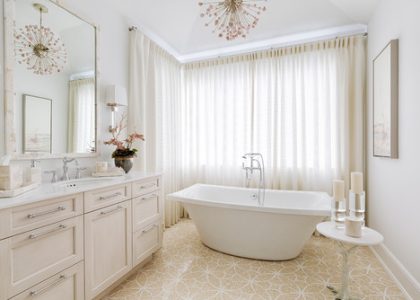When it comes to designing a bathroom, lighting plays a crucial role in creating a functional and aesthetically pleasing space. Proper lighting can enhance the overall ambiance of the bathroom, highlight key features, and provide adequate illumination for daily tasks. One key element of bathroom lighting design is the ceiling lamp. Ceiling lamps not only provide general hozo lighting for the entire space but also serve as a focal point and contribute to the overall design aesthetic. In this article, we will explore the different types of ceiling lamps for bathrooms, how to choose the right size and placement, the importance of color temperature, the benefits of LED lighting, how to incorporate ceiling lamps into your design theme, tips for maintenance and cleaning, common mistakes to avoid, and the impact of choosing the right ceiling lamp on your bathroom design.
Types of Ceiling Lamps for Bathrooms
There are several types of ceiling lamps that can be used in bathrooms, each with its own pros and cons. The most common types include flush mount, semi-flush mount, and pendant lamps.
Flush mount lamps are mounted directly against the ceiling, providing a sleek and streamlined look. They are ideal for bathrooms with low ceilings or limited space as they do not hang down and take up less vertical space. Flush mount lamps provide even lighting throughout the entire space and are available in a variety of styles to suit different design preferences.
Semi-flush mount lamps are similar to flush mount lamps but hang down slightly from the ceiling. They offer a bit more depth and dimension compared to flush mount lamps while still maintaining a relatively low profile. Semi-flush mount lamps are a great option for bathrooms with higher ceilings or when you want to add a touch of elegance to the space.
Pendant lamps are suspended from the ceiling by a chain or rod and hang down significantly lower than flush or semi-flush mount lamps. They can add a dramatic and decorative element to the bathroom design and are often used as a focal point. Pendant lamps work well in bathrooms with high ceilings or when you want to create a statement piece.
Choosing the Right Size Ceiling Lamp for Your Bathroom
When selecting a ceiling lamp for your bathroom, it is important to consider the size of the space and the height of the ceiling. Choosing the right size lamp will ensure that it is proportionate to the room and provides adequate lighting.
For small bathrooms, it is best to opt for a smaller-sized lamp that does not overwhelm the space. A flush mount or semi-flush mount lamp with a diameter of around 12-16 inches is usually sufficient. This size will provide enough light without overpowering the room.
In larger bathrooms, you can opt for a larger-sized lamp to create a more dramatic effect. A flush mount or semi-flush mount lamp with a diameter of 18-24 inches or a pendant lamp with a larger shade can work well in these spaces. Just make sure that the lamp does not obstruct any other elements in the bathroom, such as mirrors or cabinets.
The Importance of Proper Placement of Ceiling Lamps in Bathrooms
Proper placement of ceiling lamps in bathrooms is crucial to ensure even lighting throughout the space and to avoid shadows. The placement will depend on the layout and function of your bathroom.
In general, it is recommended to place the ceiling lamp in the center of the room to provide balanced lighting. This is especially important in bathrooms with low ceilings where a single central light source can help create the illusion of more height.
If you have a larger bathroom or want to add more dimension to the space, you can consider using multiple ceiling lamps. For example, placing two flush mount lamps on either side of a vanity mirror can provide even lighting for grooming tasks.
It is also important to consider any potential shadows that may be cast by the ceiling lamp. To avoid this, make sure the lamp is positioned in a way that the light is directed downwards and not towards any walls or objects that may create shadows.
How to Choose the Right Color Temperature for Your Bathroom Ceiling Lamp
Color temperature refers to the warmth or coolness of the light emitted by a lamp. It is measured in Kelvin (K) and can greatly impact the look and feel of your bathroom.
In bathrooms, it is generally recommended to use a color temperature between 2700K and 3000K. This range provides a warm and inviting light that is similar to natural daylight. It is ideal for tasks such as applying makeup or shaving as it accurately represents skin tones.
Avoid using lamps with color temperatures above 4000K in bathrooms as they can create a harsh and clinical atmosphere. These cooler temperatures are more suitable for commercial or industrial spaces.
The Benefits of Using LED Ceiling Lamps in Bathrooms

LED (Light Emitting Diode) lamps have become increasingly popular in recent years due to their numerous advantages over traditional incandescent or fluorescent lamps.
One of the main benefits of LED lighting is its energy efficiency. LED lamps consume significantly less energy compared to other types of lamps, resulting in lower electricity bills and reduced environmental impact. They also have a longer lifespan, typically lasting up to 50,000 hours or more, which means less frequent replacement and maintenance.
LED lamps are also available in a wide range of color temperatures, allowing you to choose the perfect lighting for your bathroom. They are dimmable, providing flexibility in adjusting the brightness according to your needs.
Additionally, LED lamps produce very little heat, making them safe to use in bathrooms where moisture and humidity are present. They are also more durable and resistant to shock and vibration compared to other types of lamps.
How to Incorporate Ceiling Lamps into Your Bathroom Design Theme
When selecting a ceiling lamp for your bathroom, it is important to consider the overall design theme and style of the space. The lamp should complement the existing elements and enhance the overall aesthetic.
For a modern or minimalist bathroom, a sleek and simple flush mount or semi-flush mount lamp with clean lines and a metallic finish can work well. These lamps will blend seamlessly with the contemporary design and provide a clean and streamlined look.
In a traditional or vintage-inspired bathroom, a pendant lamp with an ornate shade or a semi-flush mount lamp with decorative details can add a touch of elegance and nostalgia. These lamps will create a focal point and enhance the classic design elements in the space.
For a rustic or industrial bathroom, pendant lamps with exposed bulbs or flush mount lamps with metal accents can add a raw and rugged feel. These lamps will complement the natural materials and textures often found in these design themes.
Tips for Maintaining and Cleaning Your Bathroom Ceiling Lamp
Proper maintenance and cleaning of your bathroom ceiling lamp are essential to ensure its longevity and optimal performance. Here are some tips to keep in mind:
– Turn off the power: Before cleaning or performing any maintenance on your ceiling lamp, make sure to turn off the power at the circuit breaker to avoid any electrical accidents.
– Dust regularly: Use a soft cloth or duster to remove dust from the lampshade and any exposed parts of the lamp. Regular dusting will prevent dirt buildup and maintain the lamp’s appearance.
– Clean with mild soap and water: If your lampshade is removable, you can clean it with mild soap and water. Gently wipe it down using a soft cloth or sponge, then rinse thoroughly and allow it to dry completely before reattaching it to the lamp.
– Avoid harsh chemicals: Avoid using harsh chemicals or abrasive cleaners on your ceiling lamp as they can damage the finish or materials. Stick to mild soap and water for regular cleaning.
– Check for loose connections: Periodically check the connections and wiring of your ceiling lamp to ensure they are secure and in good condition. Loose connections can cause flickering or dimming of the light and may require professional attention.
Common Mistakes to Avoid When Choosing a Bathroom Ceiling Lamp
When selecting a ceiling lamp for your bathroom, there are some common mistakes that you should avoid to ensure you choose the best lamp for your needs:
– Neglecting the size: Choosing a ceiling lamp that is too small or too large for your bathroom can throw off the balance and aesthetics of the space. Take accurate measurements and consider the scale of the room before making a decision.
– Forgetting about functionality: While aesthetics are important, it is crucial to consider the functionality of the ceiling lamp. Make sure it provides adequate lighting for the tasks you will be performing in the bathroom, such as grooming or applying makeup.
– Ignoring the color temperature: The color temperature of the lamp can greatly impact the overall ambiance of your bathroom. Consider the desired mood and atmosphere you want to create and choose a color temperature that aligns with that vision.
– Overlooking maintenance requirements: Some ceiling lamps may require more maintenance than others. Consider how much time and effort you are willing to invest in cleaning and maintaining the lamp before making a decision.
The Impact of Choosing the Right Ceiling Lamp on Your Bathroom Design
In conclusion, choosing the right ceiling lamp for your bathroom can have a significant impact on its overall design, functionality, and ambiance. Whether you opt for a flush mount, semi-flush mount, or pendant lamp, it is important to consider factors such as size, placement, color temperature, and maintenance requirements. LED lamps offer numerous advantages over traditional lamps, including energy efficiency and longevity. By incorporating a ceiling lamp that complements your design theme and meets your specific needs, you can create a beautiful and well-lit bathroom that enhances your daily routine and provides a relaxing and inviting space.







